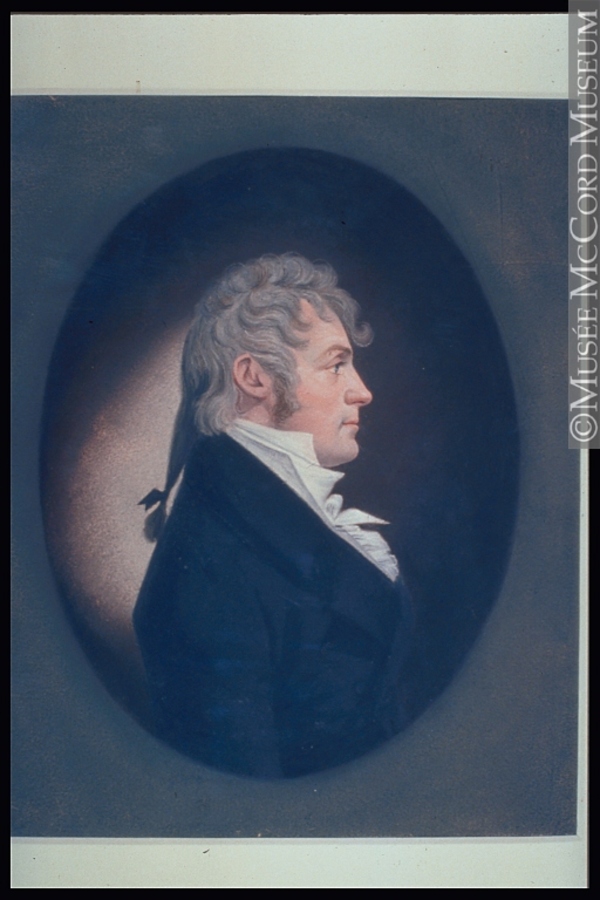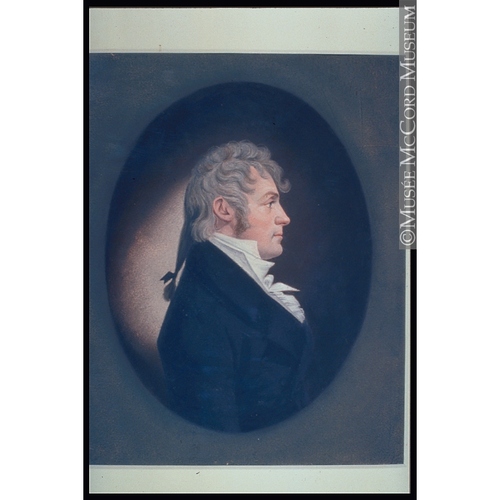
Source: Link
OGILVY, JOHN, merchant and farmer; b. c. 1769, possibly in or near Leith, Scotland, son of Jane Ogilvy, née Dunlop; d. unmarried 28 Sept. 1819 in Amherstburg, Upper Canada.
John Ogilvy immigrated to Canada about 1790, settling at Montreal, where he became involved in the fur trade. In 1792 he sent at least six men to Michilimackinac (Mackinac Island, Mich.) and three to the Mississippi country; the following year he sent nine to Michilimackinac. About 1796 he formed a partnership with William Parker and Samuel Gerrard*, and the new firm, called Parker, Gerrard, and Ogilvy, was soon engaged in the trade south and west from Michilimackinac. By 1800 the company, which was based in Montreal, had taken in a partner at Quebec, John Mure*, and jointly they ran a transatlantic shipping and passenger service; the arrangement lasted until 1811 at least. The partnership had continued to expand, and in 1803 it was known as Parker, Gerrard, Ogilvy and Company; that year Sir Alexander Mackenzie entered the firm, bringing the total number of partners to nine, each of whom had one share. Its affairs in London were confided to Sir Alexander Mackenzie, Gillespie, Parker and Company, the Quebec business to Mure, and Michilimackinac affairs to George Gillespie*; Ogilvy, Gerrard, and Thomas Yeoward attended to company matters at Montreal.
Meanwhile, in the late 1790s Ogilvy, representing Parker, Gerrard, and Ogilvy, had begun trading north and west of the Great Lakes; in 1799 he sent four canoes to Grand Portage (near Grand Portage, Minn.). The following year the intense competition of the North West Company [see Simon McTavish] drove him under the umbrella of the New North West Company, which Forsyth, Richardson and Company [see John Richardson*] and the Detroit firm of Leith, Jameson and Company had organized in 1798 in order to maintain themselves in the northwest trade in the face of the NWC’s opposition; Parker, Gerrard and Ogilvy invested nearly £8,000 in trade goods. According to the trader John McDonald, Ogilvy was “at the head” of the reorganized New North West Company, which was also known after 1799 as the New Company or the XY Company. By 1802 Ogilvy had joined with Mackenzie, Mure, the winterer James Leith*, and two other traders to form a partnership within the New North West Company called Sir Alexander Mackenzie and Company.
In 1803 competition between the New North West Company and the NWC was so fierce that, to maintain order in the northwest, the imperial government enacted a statute giving the courts of Upper and Lower Canada jurisdiction over the territory not included in the Hudson’s Bay Company charter and providing for the appointment of five justices of the peace; two, Ogilvy and Mackenzie, were named from the New North West Company and three were appointed from the NWC. However, the statute had little effect. The competition, moreover, was proving financially ruinous to both co-partnerships, and on 5 Nov. 1804 the New North West Company was brought into the NWC and accorded 25 of the 100 shares in the restructured partnership. Ogilvy and Thomas Thain* were named agents of the New North West Company in its business with the joint firm. When, a few days later, the shares of the New North West Company, which became Sir Alexander Mackenzie and Company, were divided among its partners, Ogilvy and Mure received three shares between them and Ogilvy two shares for his role as agent; one year later Parker, Gerrard, Ogilvy and Company held the fourth largest investment of the 13 partners.
In the mean time Parker, Gerrard, Ogilvy and Company had continued in the fur trade on American territory south and west of Michilimackinac. In 1806, to meet the growing competition from American traders following the Louisiana Purchase, the firm joined with Forsyth, Richardson and Company, McTavish, McGillivrays and Company, and James and Andrew McGill and Company to establish a co-partnership called the Michilimackinac Company; Ogilvy played a major role in its formation and then, as an agent of the NWC, in negotiating a division of territory between the co-partnerships. He continued until 1810 at least his work as an agent in the NWC, one of his tasks being to establish, with less favourable conditions for the traders, new contracts with those such as Jean-Baptiste Perrault* whose terms had expired. Ogilvy took a lively interest when the affairs of the Montrealers conflicted with those of American traders; in 1810 he wrote to the London house of McTavish, Fraser and Company, which was closely connected with the NWC, warning of a projected rival trading-post to be constructed on the Pacific coast by the American John Jacob Astor.
On 11 March 1802 Ogilvy had purchased from François Lévesque a two-storey stone house and lot on Rue Notre-Dame in Montreal; the purchase price was £1,500, of which Ogilvy paid £600 cash. He was already beginning to be active in community affairs, having in 1800 become an ensign in the British Militia of the Town and Banlieu of Montreal. Seven years later he was a member, with John Richardson and Louis Chaboillez, of a committee charged with the erection of a statue to Horatio Nelson. Like many Scottish expatriates at Montreal, Ogilvy was a member of the Scotch Presbyterian Church, later known as St Gabriel Street Church, and he occupied Mackenzie’s pew when the latter returned to Britain in 1805. That year Ogilvy became a trustee of the Protestant burying ground, and in 1810 he was named to the Scotch Presbyterian Church’s temporal committee; he became vice-president some time thereafter. He was possibly the John Ogilvie who was lieutenant-colonel in the Rivière du Chêne battalion of sedentary militia in 1814.
In November 1814 Ogilvy – who had already disposed of his two agent’s shares in the NWC – sold to Mure his half of the three shares they held jointly, for £7,050 and an annuity of £300 until 1823. Although Ogilvy ceased to be active in the fur trade after 1814 the experience he had acquired in it was highly respected. When in 1815 the Earl of Selkirk [Douglas], on behalf of the Hudson’s Bay Company, sought a negotiated division of the west with the NWC, he held a preliminary discussion with Ogilvy.
In 1816 the British government called upon Ogilvy’s experience in the southwest fur trade by appointing him its commissioner to determine the Canadian boundary with the United States from the St Lawrence River to Lake of the Woods, in accordance with the Treaty of Ghent, which had ended the War of 1812. “There was about him, I am informed,” said a surgeon who joined the commission later, “an unusual amount of public spirit and talent; but he was variable apt to be obstinate in trifles, and immediately; afterwards too pliant in matters of importance.” Ogilvy conducted his business with considerable zeal, his bark canoe being a familiar sight on survey locations, but also, in the view of the British Foreign Office, with rather too much expense.
Ogilvy had continued as a partner in Parker, Gerrard, Ogilvy and Company, although probably not actively after 1816. According to the Quebec Gazette, “he was perhaps the only Gentleman in the district, who quitting his commerce, turned the whole of his attention and capital to agricultural pursuits”; these followed his move to one of several farms he owned near Côte-des-Neiges (Montreal), all called Airlie. In 1815 he appointed George Moffatt*, a recent partner in Parker, Gerrard, Ogilvy and Company, to administer a trust set up to provide a solid agricultural education in Scotland for a boy named John Nelson, who, it was planned, would eventually take possession of an Airlie farm. In September 1818 one of Ogilvy’s cows was judged best in its category at a Montreal Agricultural Society livestock competition, and the following January two of his hogs received honourable mention in an exhibition by the society.
That autumn Ogilvy was at work for the boundary commission in the swampy lowlands of the Detroit River when fever struck his camp; he succumbed to it on 28 September at about age 50. He had been a sociable, cultivated man, living and working in the high style of the Montreal fur-trade bourgeoisie. The traveller John Maude, who had met him while on a trip to Niagara Falls in 1800, recorded that to Ogilvy, James Cuthbert, and Joseph Frobisher, “I shall ever feel myself indebted; less for their civilities, than for that friendly manner with which they were accompanied.” Before Maude left Montreal for the United States, Ogilvy pressed into his hands two books of poetry “as a resource against ennui” during the trip. In his will Ogilvy left, among other bequests, £100 to the Scotch Presbyterian Church and £200 “to the poor of Leith”; bequeathing a sum to one’s native parish had become almost a custom among successful Scottish expatriates. In 1821, at the suit of George Gillespie, a number of properties belonging to Ogilvy’s estate were seized from his residuary and fiduciary legatee, Moffatt, and advertised for sale at auction: there were two lots in the village of Saint-Eustache, two in the parish of Saint-Laurent on Montreal Island, one at Côte-des-Neiges, and two in the faubourg Saint-Antoine; all but the last two had houses on them.
ANQ-M, CM1, John Ogilvy, proved 5 Oct. 1819. ANQ-Q, CN1-16, 4 nov. 1814; CN1-26, 11 mars 1802. Les bourgeois de la Compagnie du Nord-Ouest (Masson), 2: 23. Docs. relating to NWC (Wallace). Mackenzie, Journals and letters (Lamb), 32, 37, 40, 208, 493–94. John Maude, Visit to the falls of Niagara in 1800 (London, 1826), 142, 160, 175–77, 181, 185, 188–89, 191, 207, 233–34, 238, 249. J.-B. Perrault, Jean-Baptiste Perrault, marchand voyageur parti de Montréal le 28e de mai 1783, L.-P. Cormier, édit. (Montréal, 1978), 111. Quebec Gazette, 11 Sept. 1800; 22 July 1802; 23 June, 27 Oct. 1808; 27 June 1811; 11 April, 28 Nov. 1816; 8 Oct. 1818; 25 Jan., 18 Oct. 1819; 6 April 1820; 4 Oct. 1821. J. R. Harper, Everyman’s Canada; paintings and drawings from the McCord Museum of McGill University (Ottawa, 1962). Massicotte, “Répertoire des engagements pour l’Ouest,” ANQ Rapport, 1942–43: 261–397. Quebec almanac, 1801: 103; 1805: 46; 1810: 58; 1815: 94. R. Campbell, Hist. of Scotch Presbyterian Church, 237–38. M. W. Campbell, NWC (1957), 124, 137, 152–55. H. G. Classen, Thrust and counterthrust: the genesis of the Canada-United States boundary (Don Mills, Ont., 1965), 95–101. Davidson, NWC, 84, 86. Innis, Fur trade in Canada (1970). E. A. Mitchell, Fort Timiskaming and the fur trade (Toronto and Buffalo, N.Y., 1977), 58, 60–61. Morton, Hist. of Canadian west (1973), 509, 606. R. A. Pendergast, “The XY Company, 1798–1804”
Cite This Article
Marjorie Wilkins Campbell, “OGILVY, JOHN,” in Dictionary of Canadian Biography, vol. 5, University of Toronto/Université Laval, 2003–, accessed December 14, 2025, https://www.biographi.ca/en/bio/ogilvy_john_5E.html.
The citation above shows the format for footnotes and endnotes according to the Chicago manual of style (16th edition). Information to be used in other citation formats:
| Permalink: | https://www.biographi.ca/en/bio/ogilvy_john_5E.html |
| Author of Article: | Marjorie Wilkins Campbell |
| Title of Article: | OGILVY, JOHN |
| Publication Name: | Dictionary of Canadian Biography, vol. 5 |
| Publisher: | University of Toronto/Université Laval |
| Year of publication: | 1983 |
| Year of revision: | 1983 |
| Access Date: | December 14, 2025 |



